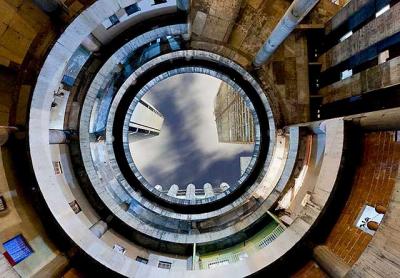Mutability and Distortion

“Image Building,” an exhibition of photographs that have architecture as their subject at the Parrish Art Museum in Water Mill, has an erudite and compelling catalog and a great number of knockout images.
Through the catalog some grand themes emerge. One of its primary theses is how photographs come to define our experience and perceptions of buildings, particularly those that no longer exist.
Citing the World Trade Center’s Twin Towers as a primary example, Marvin Heiferman in his essay notes that our first thought may be of the footage of their toppling, but images of the buildings from their inception became an immediate and indelible symbol of New York City and America. Dominating the Manhattan skyline, those towers mesmerized those who sought to shoot them in photographs and those who ultimately took them down. In visiting various countries in Europe in the decades before the towers fell, it was remarkable to see how prevalent images of that skyline were, be it in a cafe, store, newsstand, or restaurant, serving as visual shorthand for the New World.
Photography’s mutability, from its inception to the present, is just as much on view here as the buildings that serve as the focus. As a result, it is not always an easy show to wrap your arms around, and ironically the flow is sometimes broken up by the architecture of the Parrish itself. Yet certain passages are surprisingly graceful, particularly in the double gallery, which benefits from the concentration of recent large-format work of German practitioners of the Dusseldorf School.
One rather bravura transition is between Thomas Ruff’s “w.h.s. 10:” to Candida Hofer’s “Villa Borghese,” Thomas Struth’s “Pergamon Museum I, Berlin,” and his “Las Vegas, Nevada.” The pinkish hues of three of them tie them together visually, while “Pergamon” takes as its subject a museum interior in the same way as Ms. Hofer’s “Villa Borghese.” Both photographers are addressing history as viewed through these spaces and how distanced we are from these objects even when we are standing right next to them. Mr. Ruff’s digital manipulation of images of buildings creates a similar distancing, but through abstraction. Mr. Struth’s “Las Vegas” is an exterior, but its pink-toned building represents another variety of manipulated reality and manufactured experience that corresponds well to this company.
The same forces at work in visual art regarding the heroics of early Modernism and the more contemporary reactions against it are in evidence here. Therese Lichtenstein, the curator of the show, has placed Hiroshi Sugimoto and Mr. Ruff’s distorted versions next to earlier iconic images of the same sites, such as Rockefeller Center by Samuel H. Gottscho and Le Corbusier’s Ronchamp Chapel by Ezra Stoller. In further irony, the newer takes pose the same question as Picasso’s early Modernist guitar sculpture: How much visual information do we need to recognize a representation of a commonly known object, and how does the distortion affect our experience and understanding of it?
The spine gallery, one of the darkest of the darkened rooms necessary to preserve the prints, displays Balthazar Korab’s and Stoller’s striking images of Eero Saarinen’s masterpiece, the T.W.A. Flight Center at Kennedy Airport, as well as the more mundane American architecture captured in Ed Ruscha’s “Every Building on the Sunset Strip.”
The show also tackles postwar housing, from the cliffhanging shelters of Los Angeles by designers such as Richard Neutra to the banal tract homes built in this country and abroad to be affordable for young families. Julius Shulman’s collection of houses in Los Angeles and Palm Springs summons the mid-20th century in a powerfully immediate way. Aspiration is heightened in his “Case Study House, No. 22,” in which women sit in a glass box living room, adding implied decoration to the interior and a rare human presence in the exhibition.
Eschewing the slick consumerism of those sexy images, photographs by Robert Adam, Lewis Baltz, and Stephen Shore look instead to the quotidian and the marginal in singular approaches that reflect their differing aims and aesthetics. Bernd and Hilla Becher offer something similar, with an international perspective, in their “Framework Houses, Siegen District, Germany,” from 1988.
What we end up with after ambling through these rooms is a sense of the thingness of the photos themselves and the distortions inherent in the transformation of objects into subjects of photography. Mr. Heiferman’s point is well taken that, unlike some photographic subjects, the objects of architectural photography do not lose their aura. Even at their slickest, or barren and abandoned, these depictions of buildings rarely lack souls.
The exhibition will be on view through June 17.
